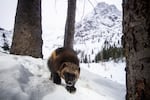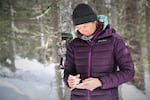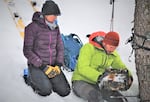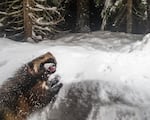Stephanie Williams and David Moskowitz deftly weave their snow machines up and around heaps of snow and jagged blocks of ice. They sometimes stand on the machines or hang off to one side, to keep them from flipping and tumbling down into the ravine cut by the Early Winters Creek.
Heavy snowfall and recent avalanches have practically erased the North Cascade Highway from this winter landscape. They travel some 15 miles up the winding snow-covered road, higher and deeper into Washington’s North Cascades.
At a spot that would be insignificant to anyone else, they stop. There is no obvious trail here, just subalpine conifers and snow.
Williams and Moskowitz unstrap their skis, shoulder their packs, and then head into the trees.
There are few places like the North Cascades; they are a dense jumble of rugged mountains, nearly impenetrable in the grip of winter. Williams’ and Moskowitz’s alpine touring skis crack the crust of ice on the snow as they break trail higher up the steep slope.
Soon, they begin to breathe steadily from the brisk pace, their cheeks get rosy and noses drip. This is where both of these backcountry enthusiasts like to be each winter, but they are not here simply for their own recreational pleasure; they’ve come for a biological research project of their own design.
What makes it challenging for people to travel into the North Cascades in the depth of winter, makes it a relatively undisturbed snowy sanctuary for the most elusive animal in these mountains: the wolverine.
The wolverine, famous for its ferocious nature, is one of the scarcest mammals in North America. It is also one of the least studied. To study wolverines in the wild, researchers have to go into the wolverine’s territory, a challenge in itself. But access is just the first part; the second, and far more difficult part, is to then find a wolverine in this vast alpine area.
Williams, a professional alpine guide, and Moskowitz, an award-winning wildlife photographer, have come to meet that challenge as citizen scientists under the banner of the Cascades Wolverine Project.

Wolverines have a reputation for being ferocious. They can dig through snow and ice with their claws, and survive the harsh winters of the North Cascades.
David Moskowitz
Spirit animal of the alpine
“Bait’s gone,” Williams calls back to Moskowitz.
Ahead, she can see that something has eaten the bait they left out a few weeks prior.
Here in a small pocket of trees they had hung a chunk of a deer carcass. It had been suspended by a wire strung between trees, but now all that remains are tufts of fur in the snow below. Williams heads to a tree where a trail camera is strapped.
She pulls down the camera and uses her phone to check the media card. Whatever took all the bait will be recorded on this card.
Williams thumbs through dozens of frames from each time the motion sensor was triggered. “A marten,” she says. With a sigh she adds, “a well-fed marten.”
Martens are related to wolverines, part of the mustelid family that includes weasels, badgers and otters. Curious, scrappy and feisty, they forage for food in the winter. But this marten likely has a den near the camera trap, and has been enjoying the free buffet.
Wolverines are larger, in fact the largest land dweller of the mustelids. With a short compact body and long sharp claws, the wolverine’s reputation is often one of ferocity. Its scientific name is Gulo Gulo, Latin for “glutton” or perhaps more accurately to this winter scavenger, ravenously hungry.
Many animals, like deer and elk, descend from the mountains in winter. Bears store up winter fat and then hibernate. Wolverines and their smaller mustelid cousins, the martens, stick around. Their high metabolism burns calories to maintain their body temperature, but to keep that internal furnace going, wolverines need to be on a constant lookout for whatever carrion scraps they can scavenge or small rodents they can hunt.
In the search for food in the snowy and icy mountains, wolverines are known to trek incredible distances. Some have home ranges larger than 240 square miles. Here in the North Cascades, these distances are up jagged mountain ridgelines and down steep river drainages.
“I think of them as the spirit animal of the alpine,” Williams said. “It’s almost like they’re playing in this terrain — up and over steep shoots, over ridges, onto the top of mountain peaks, in the dead of winter — as if it was flat ground!”
“Whether they need to dig through the snow or climb up a tree or swim across a river, they’re going to do it to get what they need,” Moskowitz said. “And it creates a really interesting personality for these critters that’s very distinctive.”

Stephanie Williams records field data in her notebook at one of the camera traps she and collaborator David Moskowitz have set up in an effort to locate Wolverines in the North Cascades.
Ian McCluskey / OPB
Counting wolverines
No one knows how many wolverines once called the North Cascades home. Their plush fur, which helps them survive in the snowy mountains, made them the targets of early fur trappers. By the 1930s, it was believed that the last of the wolverines in the Northwest had been killed off.
Sightings of wolverines were extremely rare and far between. They were considered a game animal in Oregon until 1973. In 1975, Oregon reclassified them as “threatened” under its Endangered Species Act.
In 2003, a group of volunteers with Cascadia Wild gathered to verify reports of wolverine sightings on Mount Hood. Although they were not able to confirm the sightings, they launched the continuing “Wolverine Tracking Project.”
In 2005, wildlife biologists from the U.S. Forest Service and Washington Department of Fish and Wildlife launched a monitoring project based in Washington’s Methow Valley to try to get some sense of the distribution and population of wolverines in the North Cascades. They live-trapped several wolverines. By placing satellite-telemetry collars on them, researchers were able to track the wolverines’ movements after they were released back into the wild. After a few seasons, the study expanded into southern British Columbia.
It became clear that the wolverines’ habitat was larger than anyone had imagined. It also raised the hope that wolverines from Canada may be slowly moving south, reclaiming part of their historic territory and reestablishing a population.
After the study ended in 2015, Williams and Moskowitz saw a need for continuing monitoring efforts in their own backyard of the Methow Valley. In 2017, they teamed up along with Williams’s husband, Drew, to create the non-profit Cascades Wolverine Project.
Each winter, they head into the frozen mountains and set up about a dozen camera stations. They hang bait and then return after about a week to see what the trail cameras have recorded. The first, and most obvious question the camera can answer: do any wolverines show up?
At their second station of the day, Williams checks the cameras. No wolverine. Just a Steller’s jay, known also as a “camp robber,” who was more than happy to peck away at the bait.
They replace the camera batteries and media cards and hang fresh bait. On to the next station…
They ski farther up into the mountains. Wind whips down from the ridgelines. Heavy snow starts to fall. It begins to pile onto their jackets and backpacks and fill in their ski tracks. This area is enclosed by the silence and stillness of winter places.
Williams has always called cold places home. She was raised in Michigan, and “drawn toward bigger snowier places,” she said. She moved west and found work in the mountains as a guide. The expeditions took her to the peaks of the Northwest and Alaska.
“That really opened my eyes to a great amount of wonder, including the animals that live out here,” she said. Her adventures in the mountains inspired her to pursue her advanced education in wildlife biology.
The combination of backcountry skills and biology training made Williams uniquely prepared to try to monitor wolverines.
“It’s a really good mix, having a background in ski and rock and alpine guiding,” she said, “and then training in science to be able to take those skills into the field and learn about this animal.”
Once at a conference of 20 wildlife biologists, the group of scientists was asked to raise their hand if they’d seen a wolverine. Williams had seen two. That was more than anyone else in the group.

Stephanie Williams and David Moskowitz are co-founders of the Cascades Wolverine Project, a citizen-scientist effort to locate and study the elusive wolverines of the North Cascades. David Moskowitz, and award-winning wildlife photographer, has had to create his own camera gear to withstand the harsh alpine winter conditions.
Ian McCluskey / OPB
Portraits of wolverines
“I’ve almost seen a Wolverine once,” Moskowitz said. “It ran behind my back and I looked around and found its tracks across my ski tracks.”
“They’re a small animal in a huge environment,” he said. “So just the chances of coming across them are very low. And that’s true no matter how much time you spend out here. You could sit your whole lifetime on a mountainside and never see a wolverine.”
Camera traps have been the only logical way to try to figure out where they are. Moskowitz’s background in photography not only helps in this area, but takes it to a new level of artistry.
To withstand the harsh conditions of the subalpine zone, Moskowitz had to invent his own gear. Repurposing a Pelican case and using lots of duct tape, he created a waterproof housing for his DSLR camera. He rigs strobe flashes, triggered by a remote when the trap is tripped.
“I’m doing like studio photography here,” Moskowitz said. “I’ve got different lighting set up with different powers and like I’m using a really nice camera to get portraits essentially of these wildlife.”
His camera offers rare glimpses into the cold nights of this area. Captured in split seconds are snowshoe hares, lynx and even wolverine.
“You just imagine them out here on this snowy night in the winter in the wilderness, and then there’s just this literal split-second where there’s lights exposing them, and you get this kind of window into their world,” Moskowitz said.
The photos are artistically stunning — and also offer potential scientific clues. Wolverines are often described as “bear-like” for their small round ears, and their chocolate brown and black-tinged fur. But look closer, and one can see the two streaks of lighter hair running from their heads along each side of their body, and on the chest, a color patch, called a blaze. The various differences of blazes can be one visual clue to different individuals.
Researchers can also wrap bristly brushes around tree trunks to snag hair from the wolverines as they try to reach the hanging bait. The photo of the individual matched with genetic information extracted from the hair sample creates data points like tiny pieces of a massive jigsaw puzzle that begin to show the larger picture of wolverines in the North Cascades.
“It’s a glimpse,” Williams said, “into the ongoing story of this ecosystem.”

The portraits of wolverines by wildlife photographer David Moskowitz capture candid moments in the little-known life of wolverines.
David Moskowitz
Maybe next time
Moskowitz and Williams have finished checking the third and final station for the day. No wolverines on the cameras this trip. “Typical,” Williams said.
Their lack of sightings is in itself data. The absence of wolverine may indicate a low population, perhaps lower than even estimated.
Scientists estimate that the entire wolverine population of the contiguous United States may be less than 1,000, possibly even as low as 300. The Washington Department of Fish and Wildlife estimate that there may be as few as 25 wolverines in the North Cascades.
For decades, advocacy groups have petitioned for wolverines to be listed for federal protection under the Endangered Species Act. In October 2020, after a decade of being a candidate for listing, the U.S. Fish and Wildlife Service withdrew the proposal for listing the wolverine as threatened.
“Without federal protection as an endangered species it’s hard to get that continuous monitoring effort going,” Williams said.
For now, they’ll continue their mission. Undaunted by the lack of wolverine sightings this trip, but hopeful for the possibility next time.
And, at least, the trip back out of the mountains is all downhill. They peel off the climbing skins from their skis, switch their alpine touring ski boots and bindings to downhill mode and click in.
Pushing off, they speed downhill with wide sweeping turns, kicking up a wake of spraying power with a swoosh.
Then it is only the silence of falling snow. The wild mountains are left once again to the wolverines.



